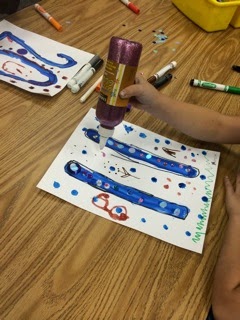Our kindergarten classes have been in session for 10 days! Here are some pictures of the alphabet art & activities we are collecting for our Alphabet Museum Display. Look at these beautiful examples!
 |
| Apple Printing |
 |
| Bubble Wrap Prints & cut b's |
 |
C collage (find C's from group of
several letters) and a cut out camera |
 |
| dots on D's |
 |
Handprint Elephants from
eisforexplore.blogspot.com |
 |
Flags painted on blue paper with red
and white paint. Card stock folded in half
and stapled to flag makes the pole. |
 |
| Glitter G's & g's |
 |
| E's with lines and curves |
 |
h horse idea from
missmarensmonkeys.blogspot.com
I somehow didn't save any that
had the h going the right way!
Oh, the life of kindergarten! |
 |
| Insect i |
A big academic focus for kindergarten students is learning alphabet letters and the sounds they stand for. Our school district uses Harcourt Trophies curriculum for reading. We feel that the pacing for learning alphabet letters is too slow as it is paced throughout the year. We like to focus on the whole alphabet at the beginning of the year, then compact the Trophies curriculum for the balance of the year and focus on writing formation of the letters, and using the sounds for emerging reading. We also utilize the Zoo-Phonics letter sounds program. This program combines an animal character and a motion along with the sound associated with the letter. The animals are very motivating and the movements really help young learners learn and remember letter sounds. We also have the Waterford Early Learning Program on computer for children. We use the Nursery Rhyme songs and books as we introduce letters to make a connection to our hands on learning to their computer time.


Our strategy is to look at a letter-a-day for the first 26 days of school. We go through them in order. Each day we compare the upper and lowercase letters, meet an animal character that helps us with the sound, listen to books and songs associated with the letter, and try one or more letter activities with the daily letter, and even eat snack associated with the letter. The culmination of our alphabet learning is an Alphabet Museum. We save items made by children during the letter learning. Then, we hang them in the hall or display in a foyer at our school. Parents are invited, other grades often use the display for learning, and our kindergarten students are thrilled at their amazing display of learning! Check out our complete Alphabet Museum idea collection at our Tpt Store:
http://www.teacherspayteachers.com/Product/Kindergarten-Alphabet-Museum-Activities-for-each-letter-459615
Yours Truly, Molly



.JPG)
















